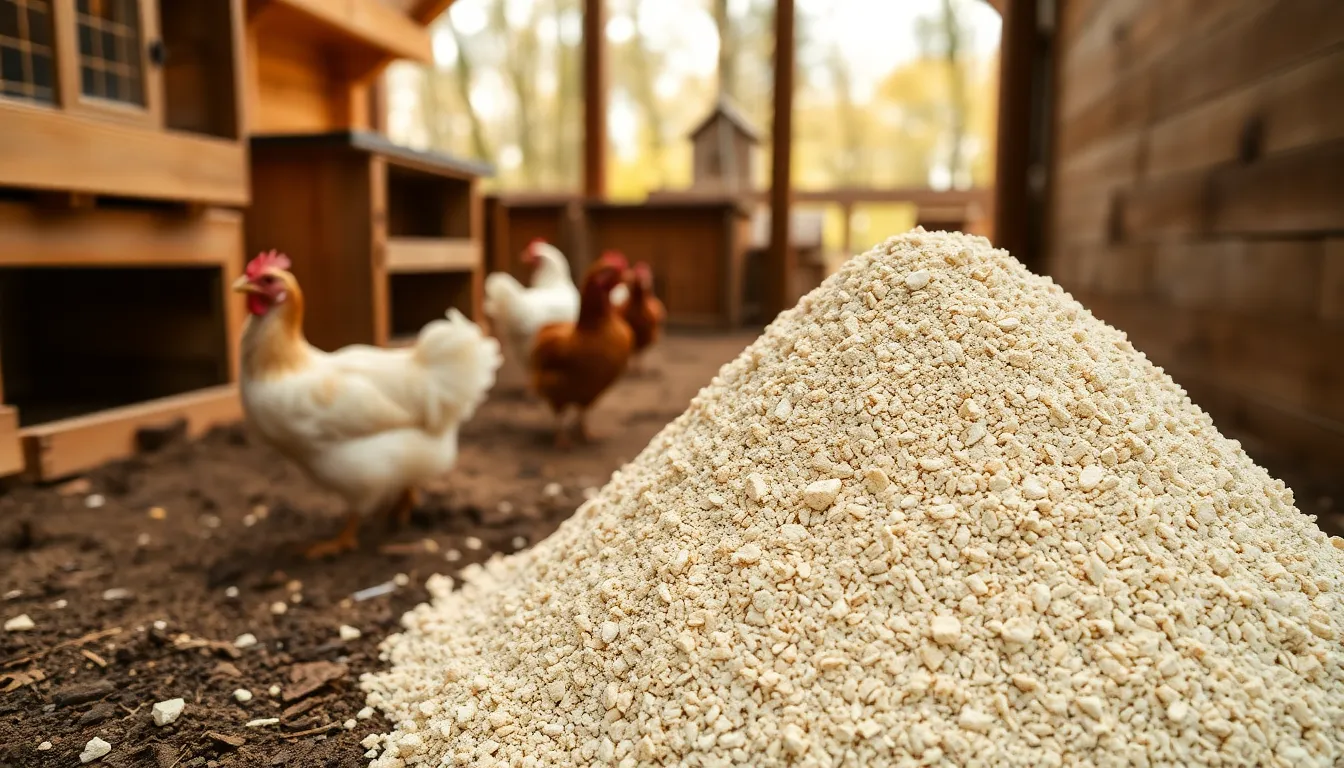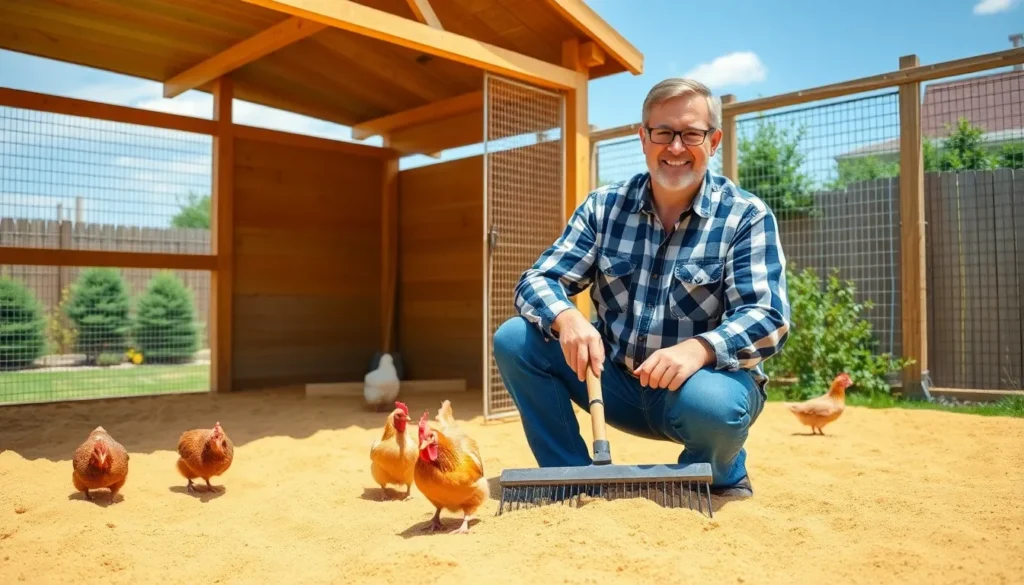Building a chicken coop? Don’t forget the secret ingredient: construction sand. While it might not be the first thing that comes to mind, this unsung hero of coop construction packs a punch. Forget about the usual wood shavings or straw; construction sand offers a clean, dry, and easy-to-maintain solution that’ll keep your feathered friends clucking with joy.
Table of Contents
ToggleUnderstanding Construction Sand for Chicken Coop
Construction sand serves as an essential material for building chicken coops. It offers an effective alternative to traditional bedding options, ensuring chickens enjoy a clean and comfortable space.
What Is Construction Sand?
Construction sand is a type of granular material extracted from natural sources such as rivers, lakes, or quarries. It typically consists of finely graded particles. This type of sand possesses excellent drainage properties. Unlike fine playground sand, construction sand contains larger grains that prevent compaction. Its texture allows for easy cleaning, which is crucial for maintaining a hygienic environment within the coop.
Benefits of Using Construction Sand
Using construction sand offers several advantages for chicken coops. First, it promotes excellent drainage, reducing the risk of moisture build-up and bacterial growth. Second, this sand type is more durable than traditional bedding materials, lasting longer under the wear and tear from chickens. Third, it minimizes odors, providing a fresher environment for both chickens and coop caretakers. Finally, construction sand requires less frequent replacement than shavings or straw, resulting in lower maintenance efforts and costs.
Types of Construction Sand

Understanding different types of construction sand helps in selecting the best option for chicken coops. Each type has unique characteristics that impact cleanliness and comfort within the coop environment.
Coarse vs. Fine Sand
Coarse sand consists of larger grains, promoting excellent drainage and aeration. This property helps prevent moisture buildup, crucial for chicken health. Fine sand features smaller grains, providing a softer surface but may compact more easily. Compaction can lead to poor drainage, increasing the risk of odors and bacteria. Opting for coarse sand is generally advisable due to its superior drainage capabilities and ease of maintenance.
Locally Sourced vs. Commercial Options
Locally sourced sand often supports regional suppliers and may be more environmentally friendly. This option typically has lower transportation costs, resulting in savings for chicken keepers. Commercial options, however, might offer specific blends designed for optimal performance in animal housing. Selecting a commercial product can provide consistency in quality and particle size. Weighing the pros and cons of each can help in making an informed decision that aligns with the coop’s needs.
Advantages of Construction Sand in Chicken Coops
Using construction sand in chicken coops offers numerous benefits, particularly in drainage and hygiene, along with comfort for the chickens.
Drainage and Hygiene
Excellent drainage capabilities define construction sand. The larger grains allow water to pass through freely, preventing puddles from forming. As moisture accumulates in traditional bedding materials, bacteria growth often occurs. Instead, construction sand minimizes this risk, ensuring a drier environment. Cleaning routines become simpler due to the sand’s properties. Residue and droppings can be easily raked away, enhancing overall hygiene. Regular maintenance remains essential, yet the frequency of replacement significantly decreases with sand compared to straw or shavings.
Comfort for Chickens
Comfort directly influences chicken well-being. Construction sand provides a soft surface for chickens to walk on, reducing stress on their feet. Unlike hard surfaces, the sand cushions impacts, promoting better mobility for the birds. Proper aeration allows chickens to dig and scratch, fulfilling natural behaviors. Additionally, sand regulates temperature effectively. In hot weather, it remains cooler than other bedding options, improving overall coop conditions. Providing a comfortable environment encourages higher egg production rates and healthier animals.
Considerations When Choosing Construction Sand
Selecting the right construction sand for a chicken coop involves several key factors that impact the overall well-being of the chickens. Understanding these considerations ensures a clean and comfortable environment.
Safety and Chemical Composition
Safety plays a crucial role in choosing construction sand. It’s important to select sand that’s free of harmful chemicals and contaminants that could harm chickens. Natural sand sourced from reliable locations typically offers a safer option. Additionally, checking for any additives or pollutants is essential, as these substances can affect the health of the flock. Analyzing the chemical composition helps ensure that the sand supports a non-toxic environment, promoting the chickens’ health and productivity.
Cost-Effectiveness
Cost-effectiveness is another important factor to evaluate. Construction sand often proves more economical than traditional bedding materials due to its durability and longevity. Lower replacement frequency reduces ongoing costs, making it a budget-friendly choice. While initial costs may vary depending on regional suppliers, the long-term savings associated with maintenance make construction sand a worthwhile investment. It simplifies cleaning routines and minimizes waste, further enhancing the overall value for chicken keepers.
Choosing construction sand for a chicken coop can significantly enhance the living conditions for chickens. Its superior drainage and low-maintenance benefits create a cleaner and healthier environment. With options available in both coarse and fine varieties, selecting the right type ensures optimal comfort and hygiene.
By prioritizing safety and chemical-free options, chicken keepers can foster a non-toxic habitat. The cost-effectiveness of construction sand further emphasizes its value, making it a smart choice for both seasoned and novice poultry enthusiasts. Embracing this innovative bedding solution can lead to happier chickens and a more efficient coop management experience.









